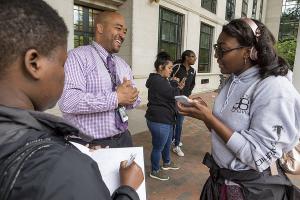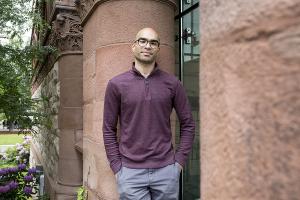Principal Damon Smith remembers a time when his students at Cambridge Rindge and Latin School in Massachusetts had a black principal, black assistant principal, black mayor, black governor, and black president – all at the same time. But he sees a need for black men to push open the door to the next frontier: the kindergarten classroom.
“We need more practitioners of color, particularly black male teachers, in our classes K-12.” he explains in his office on a recent afternoon. “President Obama is just a step. It shows you what is possible,”
His school district has made teacher diversity a priority in recent years. Ahead of this past school year, Cambridge Public Schools had 89 job openings, 44 percent of which were filled by people of color. For the coming school year, more than 44 percent of new hires for the high school alone will be people of color, according to district officials.
 A national push for more diversity among teachers has been prompted in part by research conducted since 2015 showing the positive impact that relationships – between students, and teachers who look like them – can have. At a time of racial division in the United States, educators say it is increasingly important for all children to be exposed to role models of different races.
A national push for more diversity among teachers has been prompted in part by research conducted since 2015 showing the positive impact that relationships – between students, and teachers who look like them – can have. At a time of racial division in the United States, educators say it is increasingly important for all children to be exposed to role models of different races.
“We know that teacher diversity has a positive impact not just on children of color, but on all children,” said Cassandra Herring, founder and chief executive officer of the Branch Alliance for Educator Diversity, speaking to reporters in Los Angeles during a recent panel discussion on the subject. “Early interactions with other people helps to dismantle racism… [Teacher diversity] is an academic imperative but it’s also a moral imperative.”
More than 8 out of every 10 US teachers are white and the percentage of black teachers has declined over the past three decades, despite a growing population of minority students. Black men make up only 2 percent of teachers nationwide.
To address this, a combination of grassroots and district-level programs have formed across the US in recent years to help recruit – and keep – black men in education.
In 2015, New York City Mayor Bill de Blasio launched NYC Men Teach, aimed at helping 1,000 men of color to become classroom teachers within three years. NYC Men Teach has surpassed its goal, bringing 646 male teachers of color into the district and adding 759 to the “pipeline” of those poised to enter the profession within the next two years. This past school year, 11 percent of new teacher hires were men of color – an increase from 8 percent at the launch of the program.
The same year in Philadelphia, a group of black male teachers formed an organization called The Fellowship, which hopes to have 1,000 black male educators in Philadelphia schools by 2025. Co-founder and CEO Vincent Cobb says the group has already made “significant progress,” with 100 to 150 interested applicants showing up each year at a job fair sponsored by The Fellowship.
These join older efforts such as Clemson University’s Call Me MISTER program, which started in 2000 to encourage more black men to enter and stay in teaching by providing support groups and tuition assistance. Call Me MISTER has since spread to 21 colleges and universities in South Carolina and at least five other southern states.
A way to stem dropouts
Teacher diversity makes economic sense, says Nick Papageorge, an economist at John Hopkins University in Baltimore, Md. Having at least one black teacher in elementary school reduces a black student’s probability of dropping out by 29 percent, and among low-income black males, having at least one black teacher reduced their dropout rate by 39 percent, Dr. Papageorge found in research published last year.
“Having a bunch of high school dropouts because they didn’t have a black teacher? That seems so wasteful,” says Papageorge. “Show me an economic model where wasted potential is better.”
 Currently, only 12 percent of education majors are black. And once they enter the profession, minority teachers leave teaching at higher rates than their white peers.
Currently, only 12 percent of education majors are black. And once they enter the profession, minority teachers leave teaching at higher rates than their white peers.
Black teachers quit, observers say, because of discrimination by peers, isolation, and frustration with the US education system. Black and Hispanic teachers are disproportionately employed in low-income schools with a majority of students of color, a 2016 Department of Education study found.
Much of the recruitment struggle is circular, says Papageorge. To really change teaching’s demographics, almost every black person who graduates from college would need to enter education. This is unrealistic as well as undesirable – it would take black graduates away from other professions where diversity is also needed. The long-term solution, he says, is to have more black college graduates – but that means more black high school graduates, and a major barrier to higher graduation rates is the absence of black teachers.
Manuel Fernandez, the head of school at Cambridge Street Upper School, will be celebrating 40 years in education this fall. The absence black teachers from his own education has fueled his life’s work, which Mr. Fernandez sees as an extension of what he wishes he had had as a child.
“If I don’t see people who look like me, I get messages that say, ‘I’m not to be an educator. I am not going to be a physicist. Those are not for me,’ ” says Fernandez. “We have to open up the opportunities for children in very distinct ways… have people who look like them say, ‘You can do this, because I did it.’ ”
Needed: morale boosts
Principal Smith says he entered teaching because he wanted to support young men marginalized by the education system, but at the same time he resents expectations, both stated and unstated, that black male teachers’ can “control” black young men.
“There is an opportunity because of shared experience, histories, and neighborhoods…. But that doesn’t mean that by virtue of being ‘the black principal’ that all of the black boys will all suddenly fall in line,” says Smith. “That is too heavy of a responsibility and it releases everybody else from having to do the work that needs to be done.”
Black male teachers say talking about teaching together improves their morale. Christopher Godfrey is a teacher in the all-black, all-male math department at Cambridge’s Putnam Avenue Upper School. He says it has recharged him as a teacher.
 “Being able to see myself reflected in my work… I can’t put into words what that has done for me,” says Mr. Godfrey. “It’s the coolest thing to be around.”
“Being able to see myself reflected in my work… I can’t put into words what that has done for me,” says Mr. Godfrey. “It’s the coolest thing to be around.”
Congress and the US Supreme Court have gradually narrowed the tools available to improve teacher diversity, says Catherine Lhamon, chair of the US Commission on Civil Rights. Supreme Court decisions on affirmative action over the last five decades have weakened “the lawful use of race” to create any remedy, she notes. And education funding cuts by Congress and local governments often result in teacher layoffs, which typically cut the last teachers hired – many of them teachers of color.
“It’s an issue of equity,” says Ms. Lhamon. “We need to retain a focus on the issue and how much it matters for student learning.”
Forging ahead in Cambridge
In Cambridge, Superintendent Kenneth Salim aims to increase the district’s teachers of color to 30 percent by the fall of 2020.
“[T]his is about making sure that our students are successful,” he says. “A diverse educator workforce is one important pillar of that effort.”
At present in Cambridge Public Schools, 24 percent of teachers – compared to almost 60 percent of the student body – are people of color. It’s a dramatic mismatch, yet still enough to make the district second in the state for staff diversity and is six percentage points higher than the national average.
“Our goal of 30 percent feels challenging, particularly challenging given that we know that less than 30 percent of New England graduates from teacher training programs are teachers of color,” says Ramon De Jesus, CPS’ program manager for diversity development, who was hired this past October to help the district reach its hiring goal. “But we can’t hide behind that when our students are asking us, ‘Do more’ and we have not exhausted all the possibilities.”
Mr. De Jesus says the city has become more strategic by looking for candidates from outside Massachusetts. Dr. Salim and De Jesus also say they have taken a hard look at implicit bias in their recruitment process. Looking for preconceived notions of “rigor” and “good schools” on resumes may exclude qualified candidates of color – and job descriptions with long lists of requirements might dissuade them from applying in the first place.
Last month, a diverse group of educators met for the first time in Cambridge as part of the district’s new Employee Resource Groups. The gathering, meant to promote discussion about race among teachers, is one of the steps CPS is taking to help retain its teachers of color.
Smith, the principal, is optimistic about the district being a leader in teacher diversity moving forward.
“You come back here in four or five years,” he says with a nod. “It’s going to be a lovely thing.”
